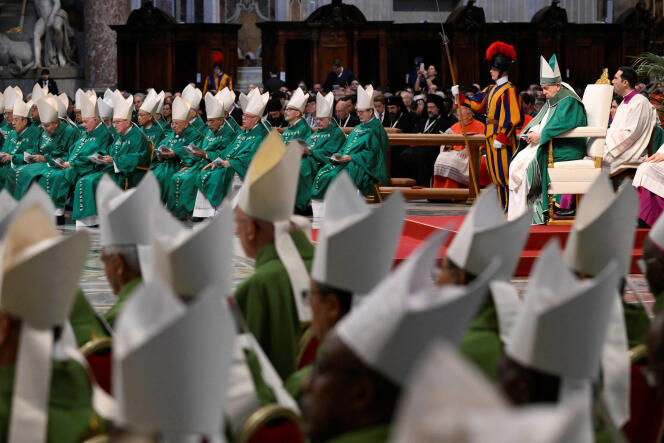LThe liturgy does not allow equality. Sunday October 29 in the morning at the closing mass of the first assembly of the Synod on synodality, this large meeting desired by Francis to reflect on the future of the Catholic Church, everyone had taken their place as they should in the basilica Saint Peter of Rome: cardinals dressed in green chasubles in first place, bishops then, also in green, and finally lay people. For four weeks, however, from October 4 to 29, they all sat side by side, around round tables set up for the occasion in the Paul VI room, in order to discuss a possible evolution in the government of the Catholic Church. .
The assembly thus, visually, embodied the change in culture desired by a pope eager to see the faithful participate more actively in the government of the institution. Historic, it even included women for the first time. 54 out of 365 were able to vote. On the menu for these four weeks of discussions, which many found a little long, based on the questions raised by the faithful from around the world interviewed for the occasion: the place of women in the Church, the inclusion of LGBTQ people, the excessive role of clerics, and the fight against abuse and sexual violence.
On Saturday evening, the assembly, which was only the first – the next, which should be conclusive, will take place in October 2024 – presented the summary report of its work in Italian. The text, although provisional, does not contain any definitive recommendations but rather poses suggestions and leaves open questions presented as “points to be resolved”. Unsurprisingly, the place of women in the Catholic Church, about which all the faithful more or less spoke in their pre-synod meetings, occupied a major place.
Divergences of views still strong
Discussions focused in particular on the possibility of ordaining women deacons, these ministers of religion whose role is to assist priests in their liturgical tasks. The chapter devoted to this question was certainly adopted on Saturday, like the rest of the text presented, but it is also the one which received the most negative votes, a sign of the still very strong differences of opinion among the prelates on the advisability to leave more room for women who represent half of the 1.3 billion Catholics. For ” some “, is it indicated, “this approach would be unacceptable because it would break with tradition”.
You have 65% of this article left to read. The rest is reserved for subscribers.
